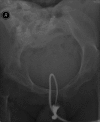Inadvertent positioning of suprapubic catheter in urethra: a serious complication during change of suprapubic cystostomy in a spina bifida patient - a case report
- PMID: 20062546
- PMCID: PMC2804015
- DOI: 10.1186/1757-1626-2-9372
Inadvertent positioning of suprapubic catheter in urethra: a serious complication during change of suprapubic cystostomy in a spina bifida patient - a case report
Abstract
Introduction: Spinal cord injury patients are at risk for developing unusual complications such as autonomic dysreflexia while changing suprapubic cystostomy. We report a male patient with spina bifida in whom the Foley catheter was placed in the urethra during change of suprapubic cystostomy with serious consequences.
Case presentation: A male patient, born in 1972 with spina bifida and paraplaegia, underwent suprapubic cystostomy in 2003 because of increasing problems with urethral catheter. The patient would come to spinal unit for change of suprapubic catheter every four to six weeks. Two days after a routine catheter change in November 2009, this patient woke up in the morning and noticed that the suprapubic catheter had come out. He went straight to Accident and Emergency. The suprapubic catheter was changed by a health professional and this patient was sent home. But the suprapubic catheter did not drain urine. This patient developed increasing degree of pain and swelling in suprapubic region. He did not pass any urine per urethra. He felt sick and came to spinal unit five hours later. About twenty ml of contrast was injected through suprapubic catheter and X-rays were taken. The suprapubic catheter was patent; the catheter was not blocked. The Foley catheter could be seen going around in a circular manner through the urinary bladder into the urethra. The contrast did not opacify urinary bladder; but proximal urethra was seen. The tip of Foley catheter was lying in proximal urethra. The balloon of Foley catheter had been inflated in urethra. When the balloon of Foley catheter was deflated, this patient developed massive bleeding per urethra. A sterile 22 French Foley catheter was inserted through suprapubic track. The catheter drained bloody urine. He was admitted to spinal unit and received intravenous fluids and meropenem. Haematuria subsided after 48 hours. The patient was discharged home a week later in a stable condition.
Conclusion: This case shows that serious complications can occur during change of suprapubic catheter in patients with neuropathic bladder. After inserting a new catheter, health professionals should observe spinal cord injury patients for at least thirty minutes and ensure that (1) suprapubic catheter drains clear urine; (2) patients do not develop abdominal spasm or discomfort; (3) symptoms and signs of sepsis or autonomic dysreflexia are absent.
Figures



Similar articles
-
The risk of intra-urethral Foley catheter balloon inflation in spinal cord-injured patients: Lessons learned from a retrospective case series.Patient Saf Surg. 2016 May 21;10:14. doi: 10.1186/s13037-016-0101-1. eCollection 2016. Patient Saf Surg. 2016. PMID: 27213016 Free PMC article.
-
Unusual complication of suprapubic cystostomy in a male patient with tetraplegia: traction on Foley catheter leading to extrusion of Foley balloon from urinary bladder and suprapubic urinary fistula--importance of securely anchoring suprapubic catheter with adhesive tape or BioDerm tube holder.ScientificWorldJournal. 2007 Sep 17;7:1575-8. doi: 10.1100/tsw.2007.253. ScientificWorldJournal. 2007. PMID: 17891318 Free PMC article.
-
Use of open-ended Foley catheter to treat profuse urine leakage around suprapubic catheter in a female patient with spina bifida who had undergone closure of urethra and suprapubic cystostomy: a case report.Cases J. 2009 Jun 12;2:6851. doi: 10.4076/1757-1626-2-6851. Cases J. 2009. PMID: 19829871 Free PMC article.
-
[Acute urinary retention: a few simple rules for a successful catheterization].Ther Umsch. 2015 Jan;72(1):39-42. doi: 10.1024/0040-5930/a000636. Ther Umsch. 2015. PMID: 25533254 Review. German.
-
[Experitoneal bladder perforation due to in-dwelling urethral catheter successfully treated by urethral drainage: a case report].Hinyokika Kiyo. 2008 Jul;54(7):501-4. Hinyokika Kiyo. 2008. PMID: 18697497 Review. Japanese.
Cited by
-
Abdominal and pelvic radiographs of medical devices and materials- part 2: neurologic and genitourinary devices and materials.Diagn Interv Radiol. 2020 May;26(3):160-167. doi: 10.5152/dir.2019.19391. Diagn Interv Radiol. 2020. PMID: 32209503 Free PMC article. Review.
-
Common genitourinary catheters: a systematic approach for the radiologist.Pediatr Radiol. 2018 Aug;48(8):1155-1166. doi: 10.1007/s00247-018-4148-2. Epub 2018 May 10. Pediatr Radiol. 2018. PMID: 29748933 Review.
-
A Foley folly: Unintended proximal urethral catheterization and balloon inflation causing urethral injury during suprapubic cystostomy exchange.J Am Coll Emerg Physicians Open. 2020 Apr 15;1(5):798-800. doi: 10.1002/emp2.12059. eCollection 2020 Oct. J Am Coll Emerg Physicians Open. 2020. PMID: 33145522 Free PMC article.
-
Update on voiding dysfunction managed with suprapubic catheterization.Transl Androl Urol. 2017 Jul;6(Suppl 2):S180-S185. doi: 10.21037/tau.2017.04.16. Transl Androl Urol. 2017. PMID: 28791237 Free PMC article. Review.
-
Obstruction of a ureter orifice by suprapubic catheter.Urol Case Rep. 2021 Jun 15;39:101756. doi: 10.1016/j.eucr.2021.101756. eCollection 2021 Nov. Urol Case Rep. 2021. PMID: 34195006 Free PMC article.
References
LinkOut - more resources
Full Text Sources

